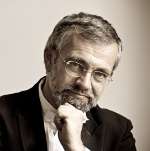I was getting ready to attend Lang Lang’s solo recital with a certain amount of trepidation. The hype was overwhelming; the best-selling classical pianist with millions of YouTube hits, concerts at the White House and at Buckingham Palace; at the Opening Ceremony of the Olympics in Beijing and the Nobel Prize concert in Stockholm; performances with a diverse range of colleagues from the heavy metal band Metallica to Plácido Domingo… The spotlight of his fame seems to whitewash the real person, the musician, the artist. Can a single person really inspire 40 million Chinese children to learn a musical instrument? And anyway, what method under the sun was used to count them?
…and then, he walked out with comfortable, measured steps. With his arms extended, he greeted the audience resembling a seasoned politician on the campaign trail before he launched into the programme. It started with the relatively rarely heard composition Tchaikovsky, The Seasons - a slightly misleading title, as the twelve character pieces are named after the months of the year. It is a pleasant enough set, with melodies reminiscent here of Eugene Onegin, there of Nutcracker, other Tchaikovsky compositions written around that time. Though not particularly technically demanding, each piece represents a different atmosphere, and Lang Lang offered a deeply nuanced reading of every character. Few composers can express melancholy as effectively as Tchaikovsky. The nostalgic anguish dominating, for example, the two pieces in G minor (March and June) was beautifully expressed through the pianist’s evocative rubato playing (loosening of a strict tempo feeling), as he freely elongated some notes, pulled others closely together and took infinite care to soften some passages. It was also memorable how the effervescent fanfare of September, recalling a hunt scene, gave way without any break to the philosophical tranquillity of the Autumn Song in October.
Whatever one’s opinion of 19th century Russian sentimentalism, the jubilant Italian Concerto by Johann Sebastian Bach felt distinctly out of place (temporally as much as in style) as the next work in the programme, and this feeling was not helped much by more Romantic music in the second half. This was particularly intriguing as the concert would have been long enough with the extensive works by Tchaikovsky and Chopin filling its two halves. While he rightly played the Italian Concerto with less freedom than afforded to him by the Tchaikovsky composition before, all was not well. The broad scale of dynamics, the strong accentuating of the beats of the two fast movements (exaggerated by the audible tapping of his left foot) and the almost ostentatious virtuosity seemed to be more misjudged than idiosyncratic in this case. It didn’t help matters that Lang Lang frequently broke the delicate balance within the voices by over-emphasising a theme, whether it was written for the right or the left hand. As a result, that particular melody may have been very clearly and repeatedly heard, but Bach’s closely knit counterpoint lost much of its magic.
The four Scherzos by Frédéric Chopin, which followed after interval, are often promoted as a cycle, although the composer never meant them to be played as such. Despite the original meaning of their title (a “joke”), there is not much that could be called humorous in these works; they are, on the other hand, brilliant and tuneful pieces, offering the perfect opportunity to demonstrate technical flair and musical imagination.
Lang Lang evidently possesses both of these qualities and this performance demonstrated pianism of the highest order. His control of his fingers is astonishing, and as a result each and every note has a purpose and a direction, even in the fastest passages, such as in the final pages of Scherzo No.3. The clarity of his soundscape is due to his extremely sensitive touch on the keyboard which, coupled with a restrained use of the pedals, was refreshing and seldom heard in this repertoire. The presto con fuoco opening of the Scherzo No.1 was indeed fiery and thunderous, while in soft passages, for example, in the middle section of the Scherzo No.2, he dared to play with a barely audible tenderness that I have never experienced in any piano recital.
Lang Lang’s artistry and immaculate technique was compelling, but packaged together with his boundless talent came the showmanship. No opportunity for entertainment was lost, even while playing: occasionally he seemed to conduct himself with one hand while playing with the other or even to "shoot" the keys of the piano à la Chico Marx. At the conclusion of the programme, he pummelled through Mozart’s famous “Turkish rondo” like there was no tomorrow, with harshly kicked accents and at a very fast speed, but then, the second encore was mesmerising in its gentleness. After several bows taken, he offered his large bouquet of flowers and his handkerchief to members of the audience. Had he had wristbands or bandanas, he probably would have thrown them into the crowd, too.


